Avenula hookeri (Spike-oat)
| Also known as: | Hooker's Oat Grass |
|---|---|
| Genus: | Avenula |
| Family: | Poaceae (Grass) |
| Life cycle: | perennial |
| Origin: | native |
| Status: |
|
| Habitat: | sun; average to dry sandy or gravelly soil; open prairies, subalpine meadows, forest openings |
| Fruiting season: | June - August |
| Plant height: | 12 to 30 inches |
| Wetland Indicator Status: | none |
| MN county distribution (click map to enlarge): |  |
| National distribution (click map to enlarge): |  |
Pick an image for a larger view. See the glossary for icon descriptions.
Detailed Information
Flower: 


![[photo of panicle]](/udata/r9ndp23q/pd3/avenula-hookeri-15-14-t.jpg) Loose, erect, raceme-like branching cluster at the top of the stem, 2 to 4 inches long, the branches ascending to erect at flowering becoming appressed in fruit. Lower branches have 1 or 2 spikelets (flower clusters) and upper branches usually have a single spikelet. Spikelets are short-stalked, 12 to 16 mm (½ to 2/3 inch) long, slightly flattened, narrowly oblong-elliptic in outline and have 3 to 6 florets.
Loose, erect, raceme-like branching cluster at the top of the stem, 2 to 4 inches long, the branches ascending to erect at flowering becoming appressed in fruit. Lower branches have 1 or 2 spikelets (flower clusters) and upper branches usually have a single spikelet. Spikelets are short-stalked, 12 to 16 mm (½ to 2/3 inch) long, slightly flattened, narrowly oblong-elliptic in outline and have 3 to 6 florets.
![[close-up of spikelet]](/udata/r9ndp23q/pd3/avenula-hookeri-3-t.jpg) At the base of a spikelet is a pair of bracts (glumes), both thin and papery, hairless, keeled, elliptic with a pointed tip, 3 to 5-veined, the lower glume 9 to 13 mm (to ~½ inch) long, the upper glume slightly longer than the lower glume and about as long as or slightly shorter than the spikelet. Florets are surrounded by a pair of bracts (lemma and palea), the lemma thicker than the glumes, 5 to 7-veined, hairless, the body 10 to 13 mm long, notched and forming 2 pointed teeth at the tip with an awn arising from midway up the back, the awn 10 to 17 mm long and initially straight but becoming bent about the midpoint and spirally twisted on the lower half; the palea is thin and papery, shorter and narrower than the lemma, hairless except for a fringe of hairs along the edges. Arising from the base and running along the palea is a short stalk (rachilla extension), the tip of it and the base of the floret both densely covered in white hairs up to 1.5 mm long.
At the base of a spikelet is a pair of bracts (glumes), both thin and papery, hairless, keeled, elliptic with a pointed tip, 3 to 5-veined, the lower glume 9 to 13 mm (to ~½ inch) long, the upper glume slightly longer than the lower glume and about as long as or slightly shorter than the spikelet. Florets are surrounded by a pair of bracts (lemma and palea), the lemma thicker than the glumes, 5 to 7-veined, hairless, the body 10 to 13 mm long, notched and forming 2 pointed teeth at the tip with an awn arising from midway up the back, the awn 10 to 17 mm long and initially straight but becoming bent about the midpoint and spirally twisted on the lower half; the palea is thin and papery, shorter and narrower than the lemma, hairless except for a fringe of hairs along the edges. Arising from the base and running along the palea is a short stalk (rachilla extension), the tip of it and the base of the floret both densely covered in white hairs up to 1.5 mm long.
Leaves and stems: 

![[photo of leaves]](/udata/r9ndp23q/pd3/avenula-hookeri-15c-3-t.jpg) Leaves are basal and alternate mostly erect, 1½ to 8 inches long, 2 to 4 mm (less than ¼ inch) wide, lance-linear, flat or folded lengthwise, hairless, smooth to slightly rough textured on both surfaces, and whitish along the edges.
Leaves are basal and alternate mostly erect, 1½ to 8 inches long, 2 to 4 mm (less than ¼ inch) wide, lance-linear, flat or folded lengthwise, hairless, smooth to slightly rough textured on both surfaces, and whitish along the edges.
![[photo of upper sheath, ligule and node]](/udata/r9ndp23q/pd3/avenula-hookeri-78-3-t.jpg) Sheaths are hairless, the upper sheaths with overlapping edges and the lower sheaths fused along the edge (closed) for part of their length. The ligule (membrane where the leaf joins the sheath) is thin, 3 to 7 mm long, pointed to ragged at the tip and not fringed with hairs. Nodes are smooth. Stems are erect, hairless, single or a few from the base and forming loose clumps.
Sheaths are hairless, the upper sheaths with overlapping edges and the lower sheaths fused along the edge (closed) for part of their length. The ligule (membrane where the leaf joins the sheath) is thin, 3 to 7 mm long, pointed to ragged at the tip and not fringed with hairs. Nodes are smooth. Stems are erect, hairless, single or a few from the base and forming loose clumps.
Fruit: 
![[close-up of mature floret]](/udata/r9ndp23q/pd3/avenula-hookeri-1-t.jpg) Spikelets are light brown at maturity, the florets shedding individually as each grain matures, leaving the glumes behind on the stalk. Grains (seeds) are brown, narrowly elliptic, smooth with a few short hairs at the tip.
Spikelets are light brown at maturity, the florets shedding individually as each grain matures, leaving the glumes behind on the stalk. Grains (seeds) are brown, narrowly elliptic, smooth with a few short hairs at the tip.
Notes:
Spike-oat, also known by synonym Helictotrichon hookeri (or Avena hookeri in older references), is a common, cool-season grass of the northern Great Plains and Rocky Mountains, but rare in Minnesota where it reaches the eastern fringe of its range. According to the DNR, it has probably always been uncommon in MN, even before settlers plowed up most of its prairie habitat. It was listed as a Special Concern species in 1996 due to habitat loss and degradation. It is distinguished from other prairie grasses by the hairless sheaths, stems and leaves, white edging along the leaf edges, long and hairless ligule, spikelets about ½ inch long with 3 to 6 florets, hairless lemmas up to 13mm (~½ inch) long with 2 teeth at the tip and a long bent/twisted awn arising from the middle of the back, and a dense tuft of white hairs at the floret base and on the rachilla extension. Similar is Poverty Grass (Danthonia spicata), a much more common species that has hairy lemmas about half the size, ligules a fringe of long white hairs, and usually hairy leaves and sheaths. Also similar is the related Downy Oat Grass (Avenula pubescens), a non-native species not known to be in Minnesota yet, but has been found in Wisconsin and will no doubt make its way west; it also has hairy sheaths and leaves, particularly on the lower plant.
Native Plant Nurseries, Restoration and Landscaping Services ↓
More photos
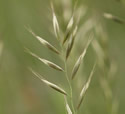 Spike-oat plant in early June
Spike-oat plant in early June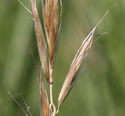 Spike-oat plant in mid June
Spike-oat plant in mid June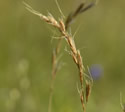 Spike-oat plant in early July
Spike-oat plant in early July lower sheaths are closed
lower sheaths are closed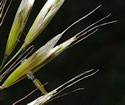 flowering spikelets
flowering spikelets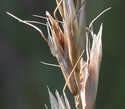 mature spikelets
mature spikelets
Photos by K. Chayka taken in Otter Tail County. Photos courtesy Peter M. Dziuk taken in Kittson, Polk and Otter Tail counties.
Comments
Have you seen this plant in Minnesota, or have any other comments about it?






